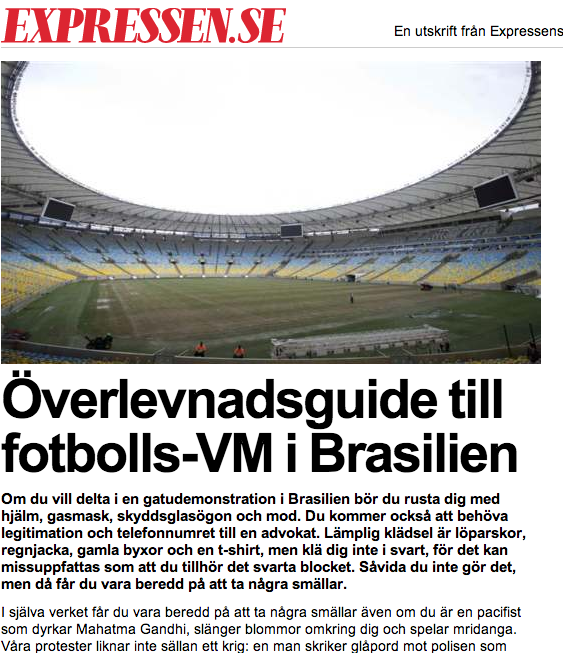Expressen (Sweden)
June 1, 2014
Text in Swedish:
http://www.expressen.se/debatt/overlevnadsguide-till-fotbolls-vm-i-brasilien/
Translation: Ylva Dark
by Vanessa Barbara
If you want to take part on a street demonstration in Brazil, it’s wise to bring a helmet, a gas mask, a pair of protection goggles and extra boldness in your bag. You’ll also need an ID card and a lawyer’s telephone number; it is advisable to wear running shoes, a raincoat, old trousers and t-shirts – don’t wear black or you could be mistaken as a supporter of the black bloc tactic. Unless you’re indeed a black bloc: in this case, be ready to take some punches.
As a matter of fact, even if you are a pacifist heir of Mahatma Gandhi, spreading flowers around and playing mridanga, be ready to take some punches. Sometimes our protests are similar to wars: a man shouts insults at the police, they answer with a gas bomb, another man throws a stone against the troops, and they begin strike everyone around, detaining dogs and hydrants likewise. At times one hard sneeze seems enough to start a war.
Until now, in São Paulo, we’ve had six mass demonstrations against the 2014 FIFA World Cup (besides other protests for better hospitals, schools and public transport). Each one gathered an average of 1,000 people escorted by 2,000 military policemen. Their job is to maintain order at any price.
More demonstrations are expected in the next few weeks – against excessive spending on stadiums, forced evictions, police violence, corruption, and inequality. The government is on the verge of imposing a state of emergency, in a desperate step to protect tourists from scenes of violence and chaos, especially from the protesters, depicted in a recent manual from the Defense Ministry as “opposing forces”.
Demonstrators have already been arrested under the old and disused National Security Law, a rule forged during the military regime. Though some of them actually damaged bank branches, they were charged with terrorism rather than vandalism. National Congress is considering a new anti-terrorist law to impute those who “cause or spread terror and panic”, a definition broad enough to incriminate everyone at the streets.
Five months ago, in the first World Cup demonstration, police detained 128 protesters. In the next one, 230 were taken to the precincts – more than 20 percent of the whole demonstration. Brazilian law prohibits arbitrary detention, limiting arrests to those caught in the act of committing a crime or those for whom a warrant was properly issued. And yet it is common practice for our police to detain “for verification”. If the subject complains, he’s charged for disrespect or resistance.
Brazilian police forces usually prevent lawyers from monitoring the arrests. They forbid journalists from filming them, and obstruct the way for protests with persuasive arguments like: “If you insist on marching this way, we’re going to beat the hell out of you”. Some officers work without identification tags. Once a captain justified this transgression by saying: “We know everybody at the troop, if you have any problem just come to me”.
According to the police, these measures are needed in order to protect themselves and “the good citizens”, while protesters denounce frequent abuses. And so they progressively see one another as enemies. Every march begins with dozens of police cars, motorcycles and helicopters zooming around, causing people to feel already intimidated. Riot troops position themselves in front, behind and at all sides of the masses, trapping them. Security guards inspect the bags and shut off subway stations. The air itself goes belligerent as unwary people look for shelters and officers raise their shields, lowering their helmets. Black blocs also cover their faces, thus protecting their identity from the police and their lungs from the gas bombs.
Demonstrators usually agree on marching peacefully, but sometimes a glass bottle is shattered or a group starts to hammer the windows of a bank, thus prompting an indiscriminate police reaction. Rageful protesters respond by kicking or throwing more objects at the police, while others just raise their hands in a reassuring way – all of them are equally and democratically beaten, gassed and arrested, including journalists and lawyers. Those who seek shelter at subway stations or inside hotels, even with the consent of their proprietors, usually see themselves trapped and detained. All of the detainees are then put on buses and transferred to some police precinct – it’s never divulged which one exactly. There the protesters are filed and accused of vandalism, terrorism, criminal association and/or corruption of minors. Sometimes investigators inquiry about their political views and connections. People may be asked to sign a blank paper before being dismissed.
Two months ago, people filed on previous protests were summoned an hour before the newly scheduled demonstration, in an admitted attempt to disband it. Although the police is officially trying to investigate those who put fire on garbage bins or destroy public and private properties, on the other hand no officer was charged on excessive violence or abuse of authority in the past year. In this period, two protesters became blind of one eye after police repression – one 18-year-old student and one photojournalist – and another one lost four teeth. (He said the policemen were so brutal that they twisted the titanium pin inserted in one of his teeth.)
Intimidation and violence are the two main weapons to maintain discipline at the streets during the World Cup. So if you’re coming to Brazil soon, you’d better have your game tickets ready to show the officers – furthermore, besides the insect repellent, it’s also wise to bring some gas masks, goggles and helmets. Just in case.


